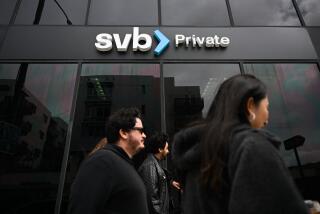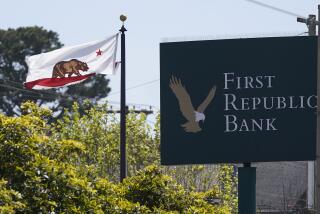Report Card Shows Wide Gap Between Best, Worst S
- Share via
WASHINGTON — The nation’s beleaguered savings and loan industry is becoming more sharply divided, with the healthy institutions now earning steady profits while “the bad ones are getting worse,” the nation’s top thrift regulator said Wednesday.
The 2,514 independent savings and loan associations suffered an overall loss of $271 million during the first quarter, but performance varied widely among different segments of the industry, according to figures issued by the Office of Thrift Supervision.
“We see at least some positive results, but this is still a very tough situation,” Timothy Ryan, OTS director, told a news conference.
Ryan’s figures showed that the well-capitalized and healthy S&Ls; made profits of about $700 million, and another group--sound but not quite as strong financially--earned about $200 million.
But these profits were far overshadowed by the deep deficit of about $1.2 billion at two groups of dangerously weak thrifts.
The fate of these badly ailing institutions is expected to play a major role in determining the ultimate cost of the S&L; bailout, the biggest financial rescue in history.
The government is slated to spend an estimated $300 billion or more over the next 30 years to finance the closing of hundreds of insolvent thrifts and to pay off depositors. Currently, federal insurance covers the first $100,000 of each account.
The government already has seized nearly 500 institutions and will report separately on how they are faring under federal control. Regulators say they may be forced to seize between 350 and 700 of the thrifts still in private hands, depending on the health of these institutions.
Ryan offered a mixed financial portrait of the S&Ls; that are still in the private sector, underscoring a wide disparity between the sick and the healthy ones.
“We see at least some positive results in identifying insolvent institutions and putting them out of business,” he said. The OTS identifies the institutions that are about to fail, and the Resolution Trust Corp. places them under government control.
The report showed that 1,264 institutions that the agency placed in the category of healthiest thrifts contained $404 billion in assets, about 38% of the total held by all the independent thrifts.
According to the regulators, all these institutions have adequate capital and are well managed. This group also has been a consistent moneymaker, despite the recent softening in the general economy and the downturn in the real estate markets.
These healthy institutions had profits of about $700 million in the first quarter, the same as they earned in the first quarter of 1989. The S&Ls; in this category have “long-term viability, and they earn an adequate return,” said Bert Ely, an independent consultant.
A second group, made up of thrifts that are profitable but fall short of the government’s new, stricter capital requirements, had much lower earnings--about $200 million in the first quarter, down from about $300 million a year ago.
The second group includes 620 S&Ls; with $326 billion in assets, or about 30% of the industry total.
Although the S&Ls; in this group were technically profitable, Ely and some other analysts are much less sanguine about them.
These thrifts “may be survivors in the regulatory sense, but they won’t make it in the marketplace,” Ely predicted. This second category of thrifts posted an anemic 6% to 7% return on equity, compared to 11% or 12% for the first group, Ely said.
The most severely wounded casualties, many of which seem likely to end up under government control, are split between groups three and four.
Those cited in group four--319 in all--generally have posted massive losses and have already been identified by federal regulators. The thrifts in this group lost about $900 million in the first quarter, far worse than the $100-million deficit in the same quarter a year ago.
These thrifts have cumulative assets of $195 billion, accounting for about 18% of the industry.
The potential nightmare for Ryan and other federal regulators comes from the prospect of widespread failure among the 311 S&Ls; in group three. They suffered losses of about $300 million in the first quarter of this year, after breaking even in the first quarter of 1989. This group has assets of $149 billion, or 14% of the industry’s total holdings.
Most S&Ls; in group three are operating under strict plans approved by the federal government to raise additional capital, and they generally restrict their lending activity until federal regulators say they are satisfied.
“We are watching these very closely,” Ryan said. “I am watching them personally on a monthly basis.”
For the two weakest categories of thrifts, “you can see the numbers. . . get worse,” Ryan said.
Ryan said the ultimate fate of many of the thrifts will depend on the real estate market, “over which we have no control.” If billions of dollars in real estate loans go bad because houses, office buildings and shopping centers cannot be sold or leased at a profitable price, the lending institutions may be dragged down.
More to Read
Inside the business of entertainment
The Wide Shot brings you news, analysis and insights on everything from streaming wars to production — and what it all means for the future.
You may occasionally receive promotional content from the Los Angeles Times.










